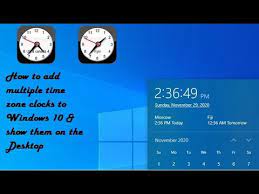Mastering Time Zones: A Comprehensive Guide to Adding Clocks from Multiple Time Zones in Windows 10

Introduction:
In our interconnected and globalized world, managing activities across different time zones has become an essential aspect of daily life. Windows 10, the versatile operating system from Microsoft, offers users the flexibility to seamlessly integrate clocks from multiple time zones, enabling efficient coordination and scheduling. In this comprehensive guide, we embark on a journey through the intricacies of adding clocks from various time zones in Windows 10, exploring the step-by-step process, customization options, and practical tips to enhance time management on your computer.
I. Understanding the Need for Multiple Time Zones:
A. Global Collaboration:
- Business: Professionals collaborating across international boundaries often need to coordinate activities across different time zones.
- Remote Teams: With the rise of remote work, managing teams dispersed around the globe requires efficient time zone synchronization.
B. Travel and Communication:
- Travel Planning: Individuals planning trips or coordinating with friends and family in different regions benefit from quick access to multiple time zones.
- Virtual Meetings: Scheduling virtual meetings with participants from various locations demands awareness of different time zones.
II. Adding Additional Clocks in Windows 10:
A. System Tray Clock:
- Right-Click: Begin by right-clicking on the system tray clock in the bottom-right corner of the taskbar.
- Adjust Date/Time: Select “Adjust date/time” to access the settings.
B. Additional Clocks Tab:
- Navigate to “Additional Clocks”: In the Date & Time settings, click on the “Additional clocks” tab.
- Check the “Show this clock” Box: Enable the option to “Show this clock.”
- Select Time Zone: Choose the desired time zone from the drop-down menu.
- Enter Display Name: Provide a display name for the clock, such as the city or region associated with the time zone.
- Apply and OK: Apply the changes and click “OK” to confirm.
III. Customizing Multiple Clocks:
A. Taskbar Display:
- Hover over Clock: Hovering over the system tray clock reveals a pop-up displaying the additional clocks.
- Quick Glance: Easily view the time in different zones without navigating through settings.
B. Alarms and Clock App:
- Windows Alarms & Clock: Open the Alarms & Clock app from the Start menu.
- World Clock: Navigate to the “World Clock” tab to view and customize multiple clocks.
- Add More Clocks: Click on the “+” icon to add more clocks, selecting time zones and customizing display names.
C. Command Prompt:
- Open Command Prompt: For advanced users, opening Command Prompt and entering specific commands allows further customization.
- Syntax Example: The command “tzutil /s “Pacific Standard Time”” sets the time zone. Replace “Pacific Standard Time” with the desired time zone.
IV. Tips for Efficient Time Management:
A. Keyboard Shortcuts:
- Windows + Alt + D: Pressing these keys simultaneously opens the additional clocks pop-up for a quick time check.
- Windows + C: The Action Center can be accessed using this shortcut, providing a glance at the time and date.
B. Time Zone Conversion:
- Online Tools: Utilize online time zone conversion tools for accurate scheduling across different regions.
- Mobile Apps: Sync time zone information across devices, including smartphones and tablets, for seamless coordination.
C. Task Scheduler:
- Automation: Windows Task Scheduler can automate tasks based on different time zones, enhancing productivity.
- Batch Files: Create batch files that execute specific actions at designated times, considering various time zones.
V. Troubleshooting and Common Issues:
A. Syncing Issues:
- Internet Time Settings: Ensure that your computer’s time and date settings are configured to sync with internet time servers.
- Windows Updates: Regularly check for Windows updates to address any time-related issues.
B. Clock Discrepancies:
- Time Zone Selection: Double-check the selected time zone for each additional clock to avoid discrepancies.
- Daylight Saving Time: Account for daylight saving time changes when setting clocks for different regions.
VI. Conclusion:
In the ever-evolving landscape of global connectivity, mastering time zones is a key skill for efficient personal and professional management. Windows 10, with its user-friendly interface and customizable features, empowers users to seamlessly integrate clocks from multiple time zones, fostering effective communication and collaboration. This comprehensive guide has illuminated the process of adding and customizing clocks in Windows 10, providing practical tips for optimizing time management. As you navigate the diverse time zones that shape our interconnected world, leveraging the capabilities of your operating system ensures that you stay on schedule and in sync with the pulse of a globalized society.




